Search Result
Results for "
visualization
" in MedChemExpress (MCE) Product Catalog:
5
Biochemical Assay Reagents
| Cat. No. |
Product Name |
Target |
Research Areas |
Chemical Structure |
-
- HY-123495
-
-
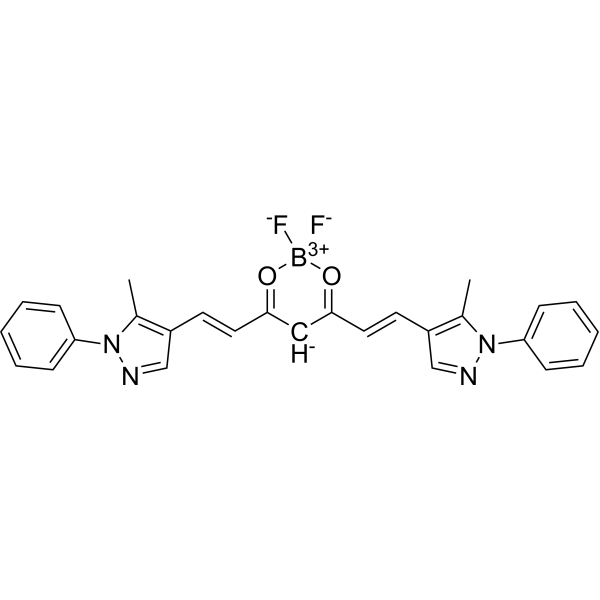
-
- HY-E70238
-
|
Nicotinamide 2-azidoadenine dinucleotide
|
Others
|
Others
|
|
2-Azido-NAD is a NAD + analog that can be used for visualization of intracellular Poly(ADP ribos)ylation (PARylation) processes .
|
-
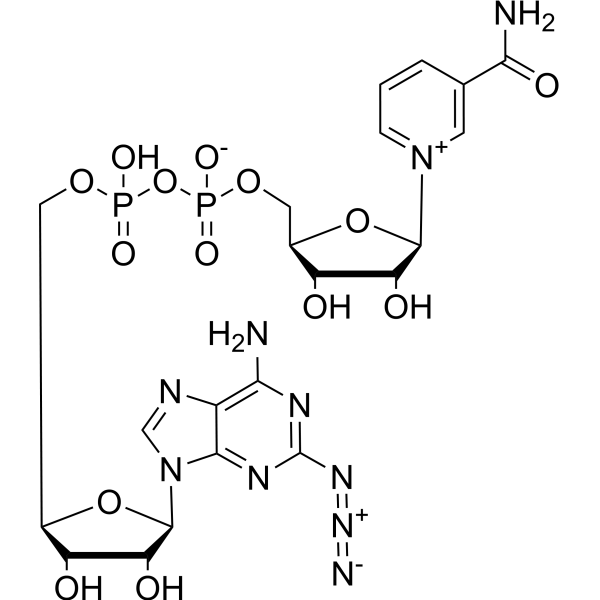
-
- HY-154850
-
|
|
STING
|
Cancer
|
|
F-CRI1 is a potent STING agonist with a Kd value of 40.62 nM. F-CRI1 is a radioactive probe with 18F-labeled modification. F-CRI1 can be used to study STING visualization in the tumor microenvironment .
|
-
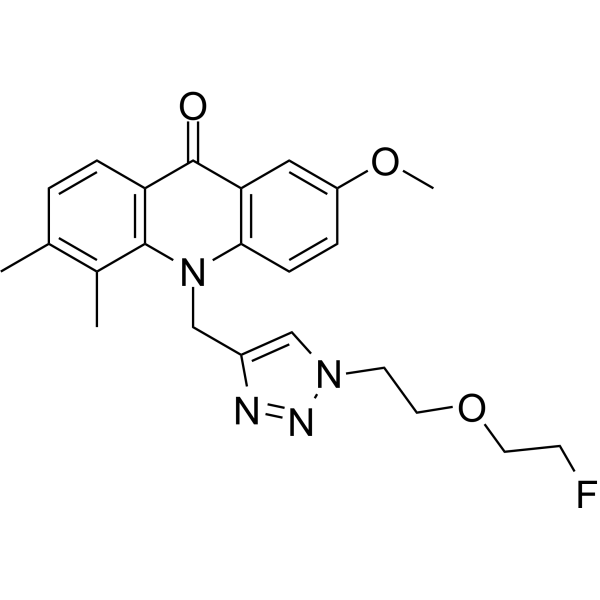
-
- HY-157765
-
|
|
PROTACs
Estrogen Receptor/ERR
|
Cancer
|
|
PROTAC ERα Degrader-6 (compound A3) is a potent PROTAC degrader of ERα, with DC50 of 0.12 μM. PROTAC ERα Degrader-6 has anti-tumor effect. PROTAC ERα Degrader-6 is a fluorescent probes with Em of 582 nm that enable real-time visualization of ERα protein degradation .
|
-
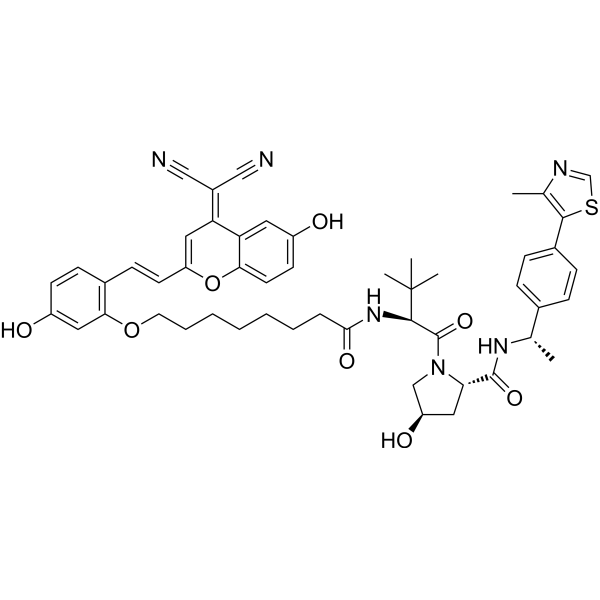
-
- HY-152901
-
|
|
Fluorescent Dye
|
Others
|
|
Chol-N3 is a bioorthogonal-based chol probe. Chol-N3 can combine with super-resolution fluorescence microscopy (SRM), providing direct visualization of nanoscale lipid heterogeneity in the cell surface of resting living cells . Chol-N3 is a click chemistry reagent, it contains an Azide group and can undergo copper-catalyzed azide-alkyne cycloaddition reaction (CuAAc) with molecules containing Alkyne groups. Strain-promoted alkyne-azide cycloaddition (SPAAC) can also occur with molecules containing DBCO or BCN groups.
|
-

-
- HY-B0266
-
|
|
Biochemical Assay Reagents
|
Others
|
|
Gadodiamide hydrate is a gadolinium-based contrast agent used in MR imaging procedures to assist in the visualization of blood vessels.
|
-

-
- HY-B0787
-
|
|
Biochemical Assay Reagents
|
Others
|
|
Gadodiamide(Omniscan) is a gadolinium-based MRI contrast agent, used in MR imaging procedures to assist in the visualization of blood vessels.
|
-
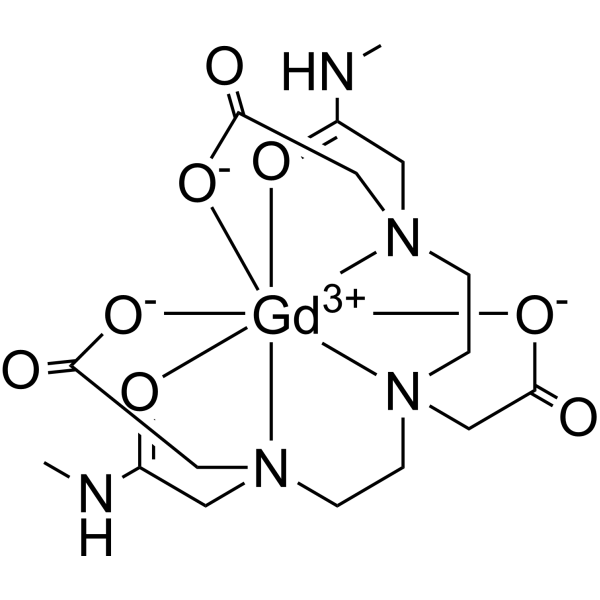
-
- HY-D1751
-
|
|
Fluorescent Dye
PKC
|
Others
|
|
RIM-1 is a fluorescent probe for protein kinase C (PKC) that can be used to visualize the distribution of PKC in cells.
|
-

-
- HY-A0223
-
|
Pantopaque
|
Biochemical Assay Reagents
|
Others
|
|
Iophendylate (Pantopaque) is a highly lipophilic substance, and can be used as a contrast medium. Iophendylate is mainly for brain and spinal cord visualization .
|
-
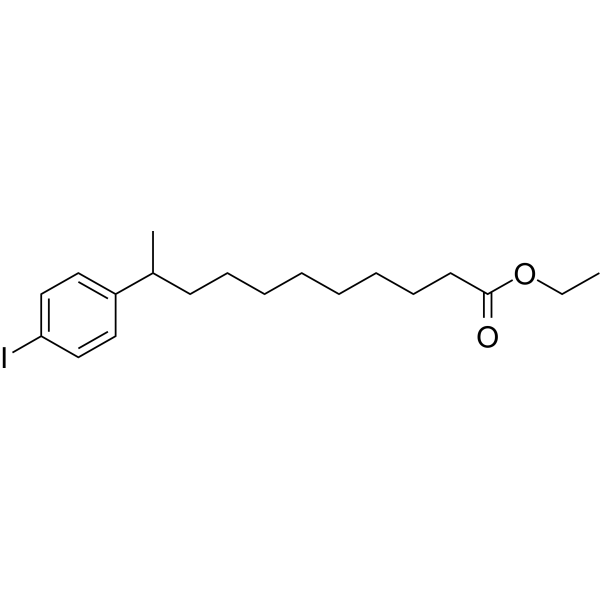
-
- HY-15930C
-
|
BM blue monosulfate; Sure Blue TMB monosulfate
|
Fluorescent Dye
|
Others
|
|
TMB monosulfate is a chromogenic substrate used in staining procedures in immunohistochemistry as well as being a visualizing reagent used in enzyme-linked immunosorbent assays (ELISA).
|
-

-
- HY-D2248
-
|
|
Fluorescent Dye
|
Others
|
|
ICG-TCO is a fluorescent dye coupled by Indocyanine Green (ICG) and TCO. ICG-TCO can be used for detection and visualization of tetrazine-containing molecules.
|
-
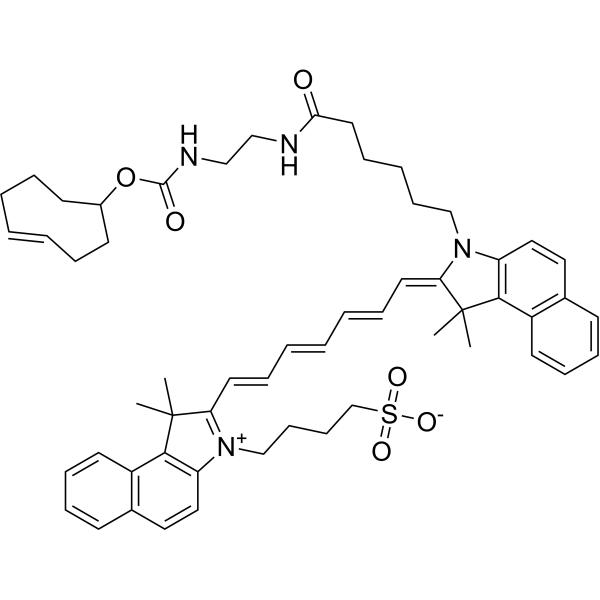
-
- HY-D1350
-
|
|
Fluorescent Dye
|
|
|
5-ROX-alkyne is a rhodamine dye that labels DNA fragments. It enables visualization of the results of capillary electrophoresis genotyping experiments and gel shift experiments.
|
-
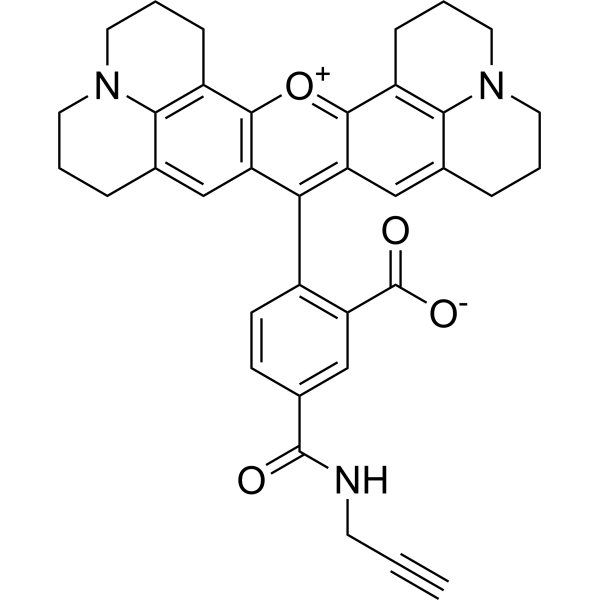
-
- HY-12489A
-
|
Acid Red 112, BS
|
Biochemical Assay Reagents
|
Others
|
|
Both Ponceau S and Ponceau BS are synthetic dyes commonly used in biological research. They are commonly used as protein stains to visualize proteins in western blots and other protein detection analyses. Ponceau S is a red dye, while Ponceau BS is a blue shade of the same dye. Both dyes bind to positively charged amino acid residues in proteins for easy visualization. However, Ponceau S is more commonly used due to its higher sensitivity.
|
-
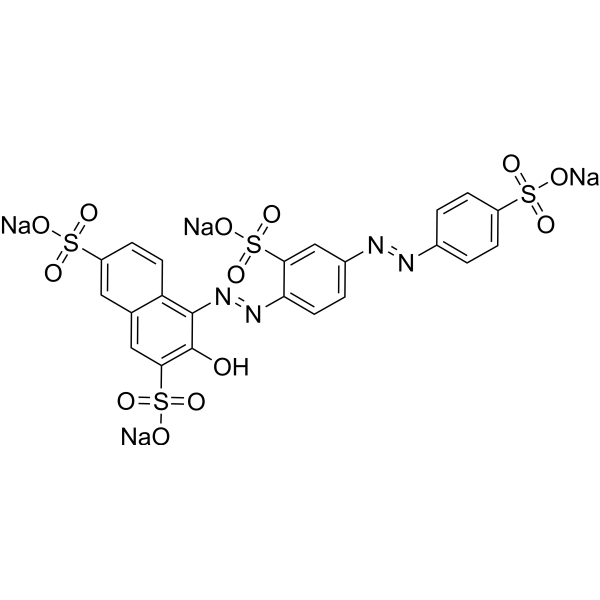
-
- HY-W248594
-
|
|
Fluorescent Dye
|
Others
|
|
IR 813 tosylate is a near-infrared (NIR) fluorescent dye (λex=815 nm, λem=840 nm) and can be used for visualizing regional lymph nodes in mice .
|
-
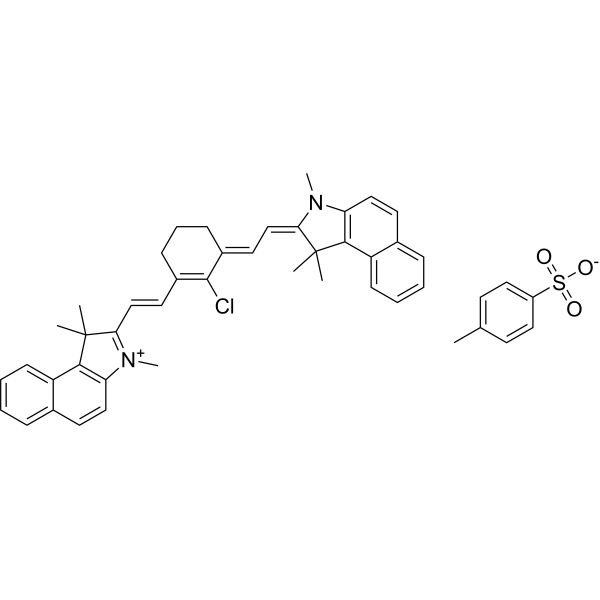
-
- HY-D2302
-
|
|
Fluorescent Dye
|
Others
|
|
mgc(3Me)DEAC (compound mgc3MeDEAC) is a small-molecule fluorescent probe enabling visualization of the Golgi apparatus in living cell .
|
-

-
- HY-D1535
-
|
|
Fluorescent Dye
|
Others
|
|
IR 813 perchlorate is a near-infrared (NIR) fluorescent dye (Ex=815 nm, Em=840 nm) and can be used for visualizing regional lymph nodes in mice .
|
-

-
- HY-D1542
-
|
|
Fluorescent Dye
|
Cancer
|
|
Mucicarmine is used in the histological visualization of acid mucopolysaccharides in tissue sections. Mucicarmine can identify mucin (deep rose), which is useful in determining the mucin positive cancer (such as liver carcinoma) .
|
-

-
- HY-161502
-
|
|
Fluorescent Dye
|
Others
|
|
DHX-SP is a fluorescent probe, which visualizes superoxide anion (O2 ·–) and peroxynitrite (ONOO –) during ferroptosis of PC12 cells and in the Parkinson’s disease model .
|
-

-
- HY-D1311
-
|
|
Fluorescent Dye
|
|
|
R110 azide, 6-isomer is an isomer of rhodamine dye with an azide group that labels DNA fragments. It enables visualization of the results of capillary electrophoresis genotyping experiments and gel shift experiments.
|
-
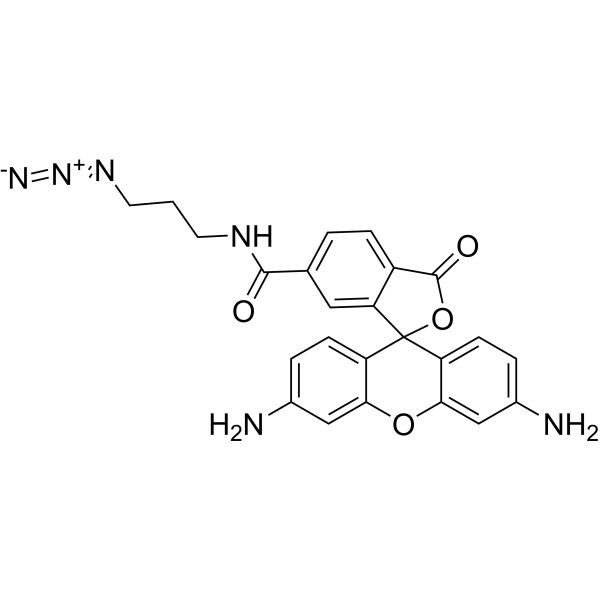
-
- HY-153797
-
-

-
- HY-W007967
-
|
|
Others
|
Others
|
|
4-Chloronaphthalen-1-ol is a substrate of horseradish peroxidase. 4-Chloronaphthalen-1-ol can be used to visualize protein bands in western blotting .
|
-

-
- HY-D1525
-
|
|
Fluorescent Dye
|
Others
|
|
N-(7-Nitrobenzofurazan-4-yl)phallacidin is a fluorochrome. N-(7-Nitrobenzofurazan-4-yl)phallacidin can be used visualizing probe for actin .
|
-
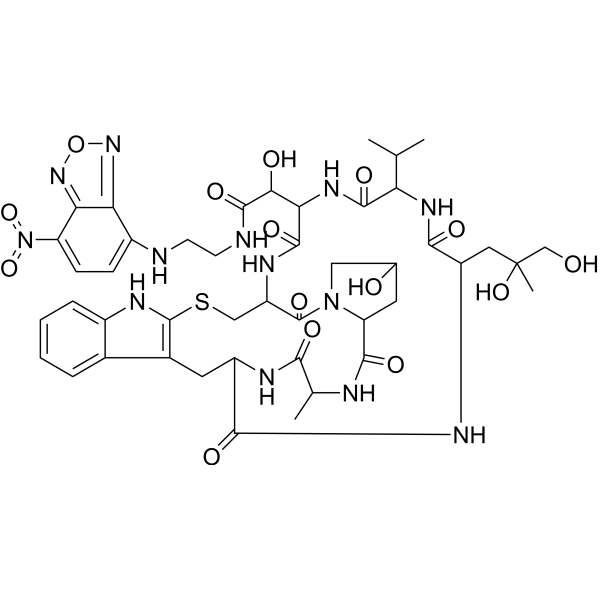
-
- HY-151890
-
|
|
Fluorescent Dye
|
Cancer
|
|
NIR-βgal-2 is a β-galactosidase-activated near-infrared fluorescent probe with superior sensitivity. NIR-βgal-2 can be used for visualizing β-galactosidase in breast cancer .
|
-
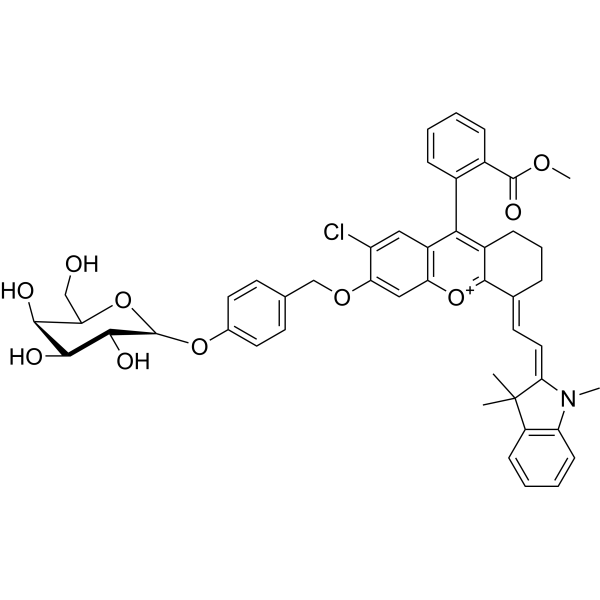
-
- HY-133520
-
|
|
Fluorescent Dye
|
Others
|
|
HBC620 is a HBC analog. HBC is nonfluorescent in solution, but emits strong fluorescence upon forming tight complex with Pepper RNA aptamer. HBC-Pepper complex can be used to visualize RNA dynamics in live cells .
|
-
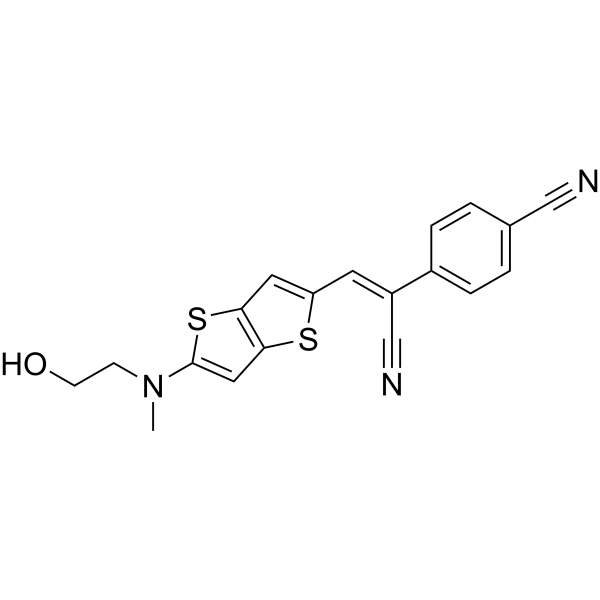
-
- HY-133521
-
|
|
Fluorescent Dye
|
Others
|
|
HBC599 is a HBC analog. HBC is nonfluorescent in solution, but emits strong fluorescence upon forming tight complex with Pepper RNA aptamer. HBC-Pepper complex can be used to visualize RNA dynamics in live cells .
|
-
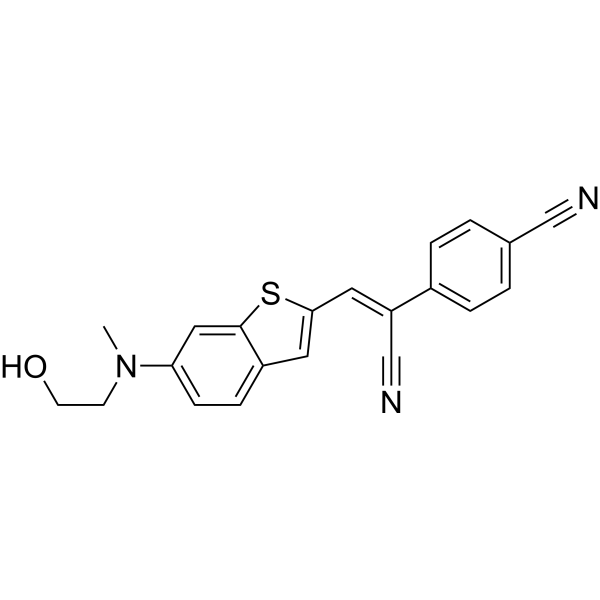
-
- HY-D2119
-
|
|
Fluorescent Dye
|
Cancer
|
|
CQ-Lyso is a lysosome-targeting chromenoquinoline. CQ-Lyso is a fluorescent probe for measuring the pH of lysosomes in living cells using only single wavelength excitation. CQ-Lyso can visualize the dynamic pH changes in lysosomes .
|
-
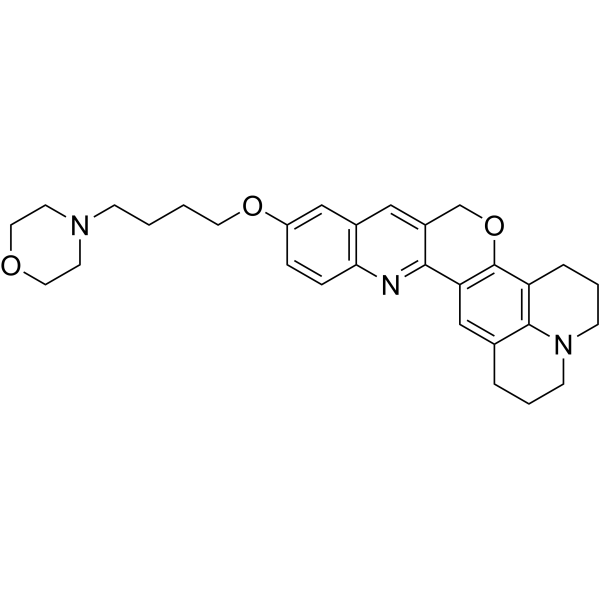
-
- HY-P3152
-
|
|
Biochemical Assay Reagents
|
Others
|
|
Streptavidin is a ∼60 kDa homotetramer. Streptavidin binds four molecules of biotin with the highest affinity. The binding affinity of biotin to streptavidin is one of the highest reported for a non-covalent interaction to date, with a KD ∼ 0.01 pM . Streptavidin has an immunosuppressive role .
|
-
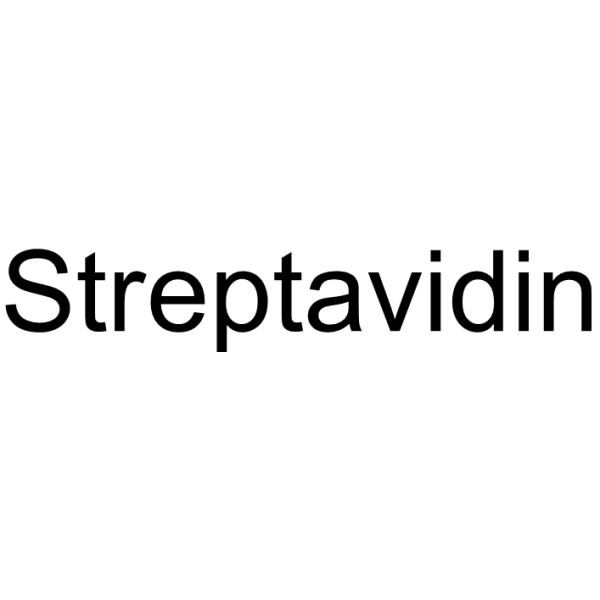
-
- HY-D2263
-
|
|
Fluorescent Dye
|
Others
|
|
BODIPY-cholesterol conjugate-3 (compound 7) is a cholesterol analogue with a fluorescent BODIPY group. BODIPY-cholesterol conjugate-3 can be used to simultaneously visualize multiple cholesterol pools in cells, as it is primarily localized to the plasma membrane .
|
-

-
- HY-D2255
-
|
|
Fluorescent Dye
|
Others
|
|
BDP FL ceramide, a highly fluorescent lipid, is a conjugate of green-emitting BDP FL fluorophore with sphingosine. BDP FL ceramide can be used for the visualization of the Golgi apparatus via fluorescence microscopy.The excitation wavelength is 503 nm and the emission wavelength is 509 nm .
|
-
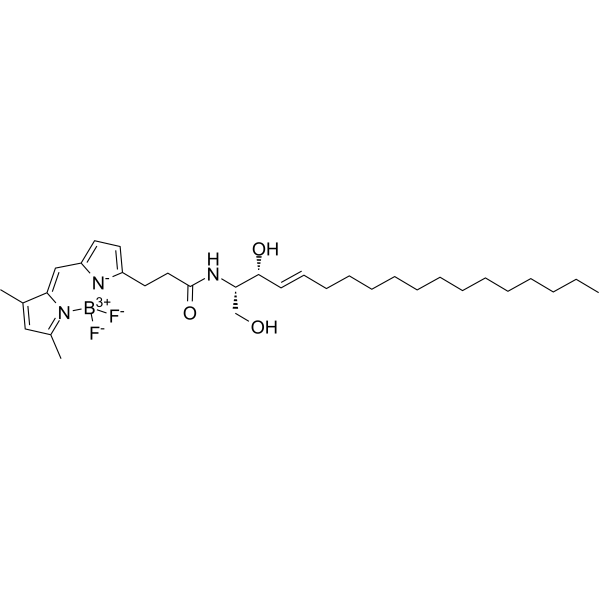
-
- HY-163386
-
|
|
Biochemical Assay Reagents
|
Others
|
|
HFTC-HClO 1 is a stable and sensitive ratiometric probe, which images the endogenous HClO. HFTC-HClO 1 exhibits a main emission peak at 579 nm. HFTC-HClO-1 visualizes HClO generated in the rheumatoid arthritis mouse model .
|
-
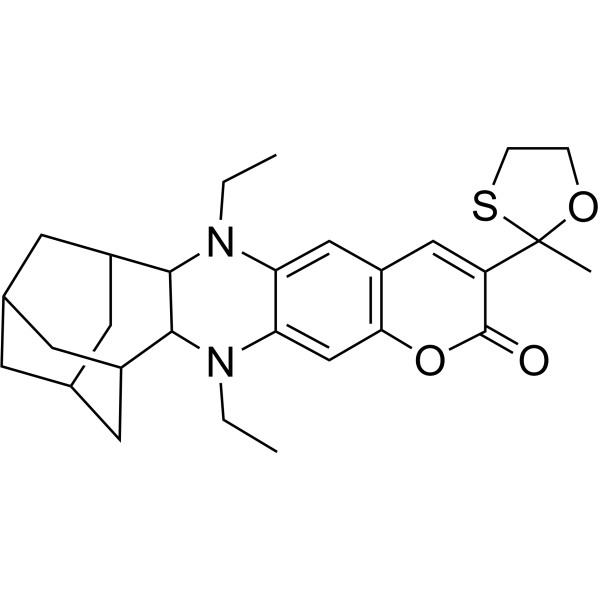
-
- HY-148465
-
|
|
Biochemical Assay Reagents
|
Cardiovascular Disease
Cancer
|
|
Gadoteric acid is a macrocyclic, paramagnetic, gadolinium-based contrast agent that can be used for magnetic resonance imaging (MRI) of the brain, spine, and related tissues. In particular, Gadoteric acid is able to detect and visualize areas of blood-brain barrier disruption and abnormal vascular distribution .
|
-
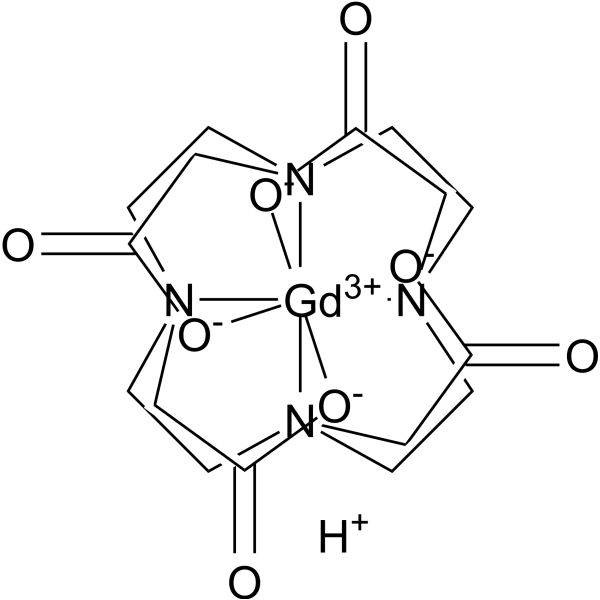
-
- HY-153846
-
|
|
Others
|
Others
|
|
RNA Aptamer Mango Ⅰ (sodium) consists of 39 nucleotides and has an exceptionally high affinity to TO1-biotin (a thiazole orange derivative fluorophore). RNA Aptamer Mango Ⅰ (sodium) can be used to visualize RNA expression or localization in live cells.
|
-

-
- HY-153850
-
|
|
Others
|
Others
|
|
RNA Aptamer Peach Ⅰ (sodium) has an exceptionally high affinity to TO3-Biotin (TO3-B, red channel, ex: 637 nm, em: 658 nm), and can be used to visualize RNA expression or localization in live cells.
|
-
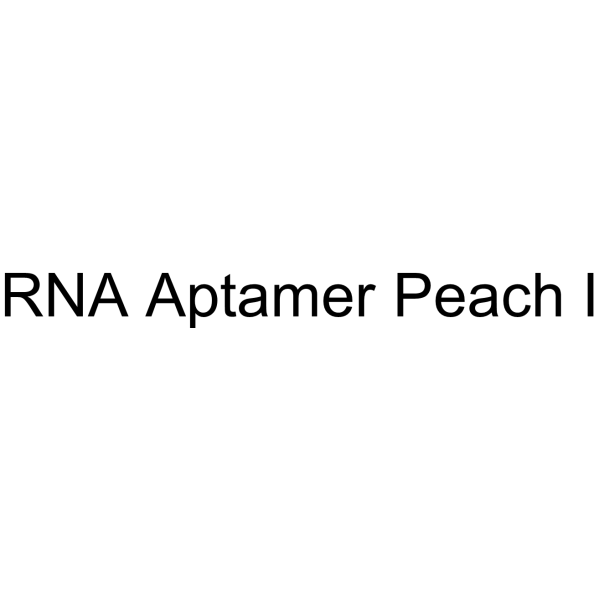
-
- HY-153851
-
|
|
Others
|
Others
|
|
RNA Aptamer Peach Ⅱ (sodium) has an exceptionally high affinity to TO3-Biotin (TO3-B, red channel, ex: 637 nm, em: 658 nm), and can be used to visualize RNA expression or localization in live cells.
|
-
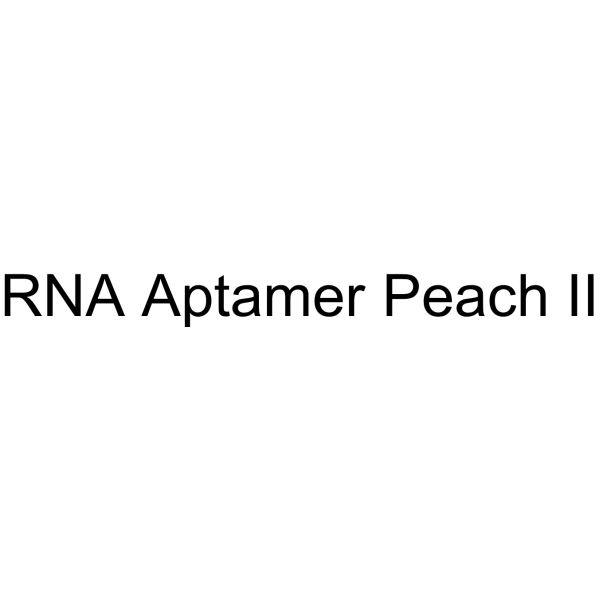
-
- HY-149765
-
|
|
Others
|
Others
|
|
Bone-1064 is a EuK-based PSMA tetramer bone probe for high-contrast visualization of bone in surrounding tissue. Bone-1064 specifically binds hydroxyapatite in bone tissue and can be used for NIR-II fluorescence imaging in animal models .
|
-
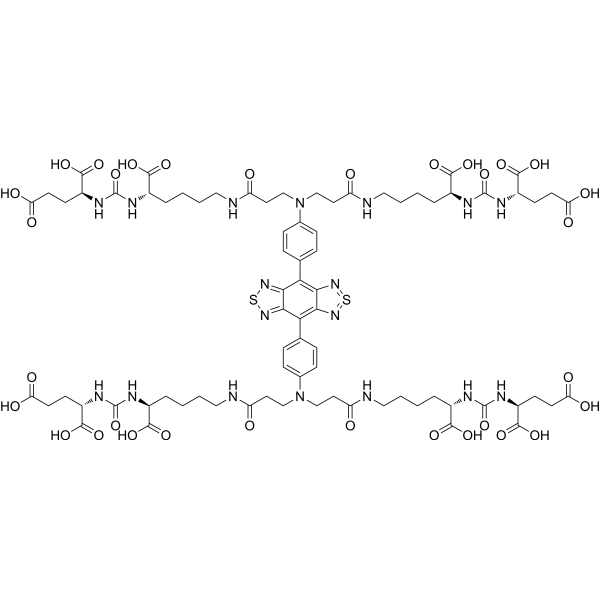
-
- HY-D2261
-
|
|
Fluorescent Dye
|
Metabolic Disease
|
|
BODIPY-cholesterol conjugate-1 (compound 5) is a BODIPY-cholesterol conjugate. BODIPY-cholesterol conjugate-1 is a useful probe for simultaneous visualization of intracellular cholesterol pools and for monitoring cholesterol efflux from cells to extracellular acceptors . (λex 541 nm, λem 615 nm).
|
-
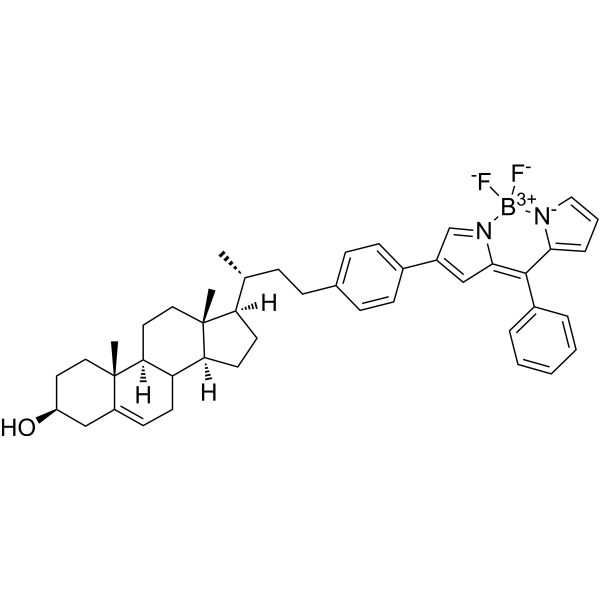
-
- HY-101185
-
|
|
Tau Protein
|
Neurological Disease
|
|
T808 is a tau-selective Alzheimer’s PET ligand. T808 is a type of imaging agent used in positron emission tomography (PET) scans. It is a radiotracer that is used to help visualize certain areas of the body, such as the brain, in order to diagnose and monitor various medical conditions .
|
-
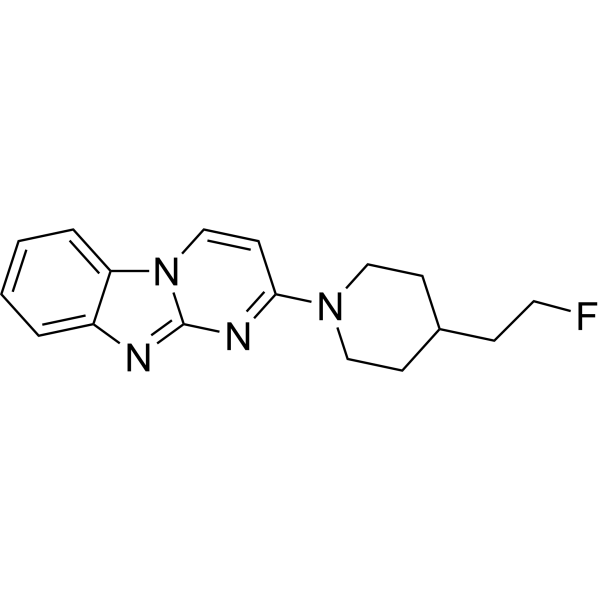
-
- HY-113017
-
|
|
Endogenous Metabolite
|
Others
|
|
Neuraminic acid is an acidic amino sugar with a backbone formed by nine carbon atoms. Neuraminic acid may also be visualized as the product of an aldol-condensation of pyruvic acid and D-mannosamine (2-amino-2-deoxy-mannose). Neuraminic acid is a functional group of some biologically active mucoproteins .
|
-
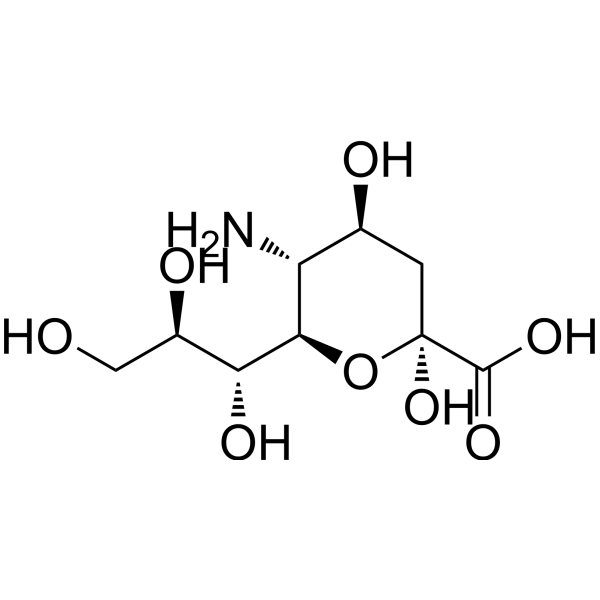
-
- HY-W133919
-
|
|
Biochemical Assay Reagents
|
Others
|
|
Aniline Blue sodium is a water-soluble dye commonly used as a biological stain for the detection of nucleic acids and proteins in various laboratory procedures such as electrophoresis and microscopy. Aniline Blue sodium has unique chemical properties that allow it to bind to specific cellular components, producing a color change that facilitates their visualization and analysis.
|
-

-
- HY-B1157
-
|
Trisoralen; Trioxysalen; TMP
|
DNA Alkylator/Crosslinker
|
Inflammation/Immunology
|
|
Trioxsalen (Trisoralen), a psoralen derivative, is a photochemical DNA crosslinker. Trioxsalen only works after photoactivation with near ultraviolet light. Trioxsalen is a photosensitizer that can be used for the research of vitiligo and hand eczema. Trioxsalen is used for visualization of genomic interstrand cross-links localized by laser photoactivation .
|
-
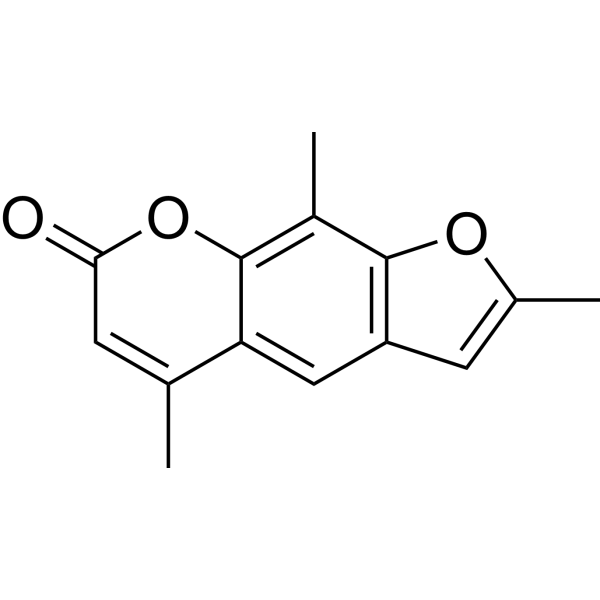
-
- HY-D2262
-
|
|
Fluorescent Dye
|
Metabolic Disease
|
|
BODIPY-cholesterol conjugate-2 (compound 6) is a BODIPY-cholesterol conjugate. BODIPY-cholesterol conjugate-2 is a useful probe for simultaneous visualization of intracellular cholesterol pools and for monitoring cholesterol efflux from cells to extracellular acceptors. (λex=589 nm, λem=638 nm) .
|
-
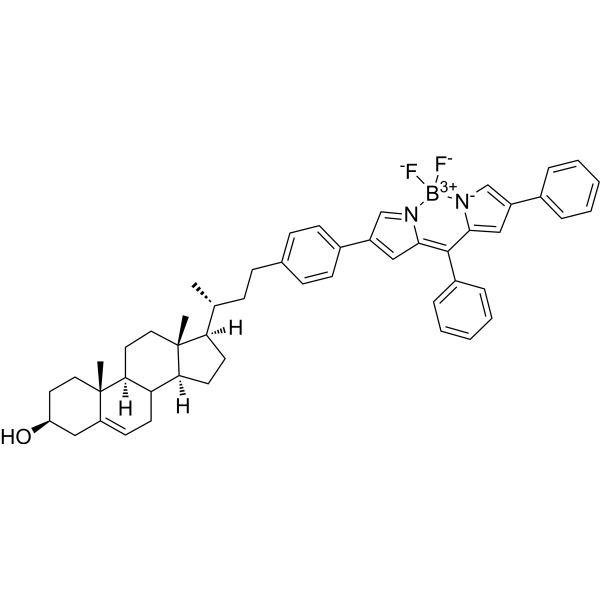
-
- HY-133523
-
|
|
Fluorescent Dye
|
Cancer
|
|
HBC514 is a nonfluorescent HBC-analog but emits strong green fluorescence upon forming a tight complex with Pepper RNA aptamer. HBC514-Pepper complex enables visualization of RNAs and the fluorescences can be altered flexibly by simple washing and staining in living Pepper-tagged cells[1].
|
-
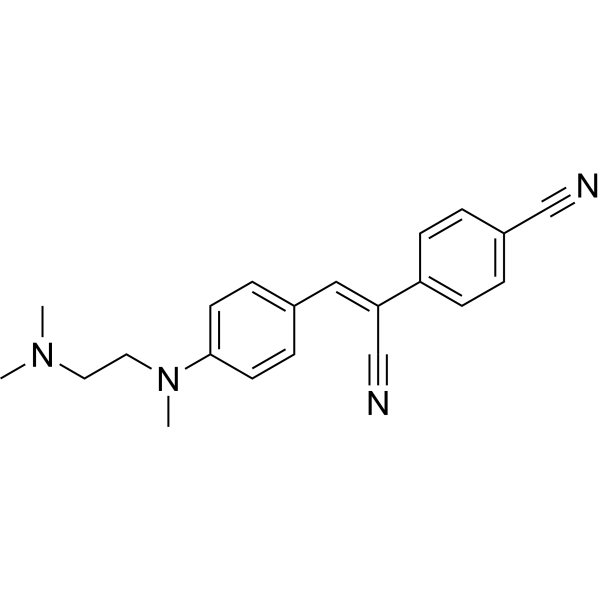
-
- HY-151544
-
|
|
Fluorescent Dye
|
Others
|
|
PNE-Lyso is a activatable fluorescent probe. PNE-Lyso can be used to detect intracellular pH and hexosaminidases with two kinds of fluorescence signals. PNE-Lyso can be used to distinguish apoptosis from necrosis through visualizing lysosome morphology. PNE-Lyso is capable of investigating the agent-induced cell death process .
|
-
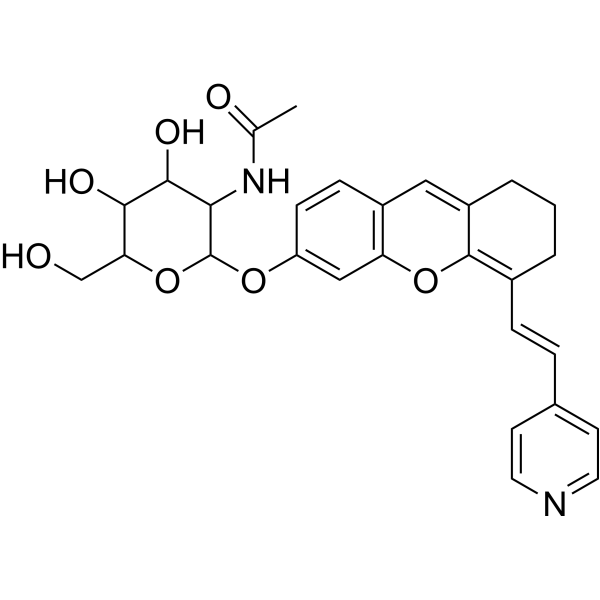
-
- HY-151537
-
|
|
Fluorescent Dye
|
Infection
Inflammation/Immunology
|
|
Gol-NTR is a Golgi-targetable probe with high selectivity and sensitivity. Gol-NTR is Nitroreductase (NTR)-activated and has visualization acute lung injury (ALI) and repair function. Gol-NTR has a low detection limit of 54.8 ng/mL. Gol-NTR can be used for the research for monitoring and assessing research response of sepsis-induced ALI .
|
-
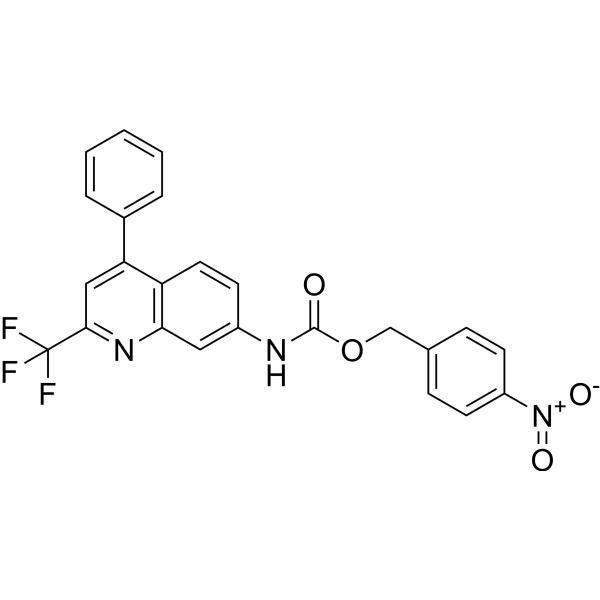
-
- HY-153847
-
|
|
Others
|
Others
|
|
RNA Aptamer Mango Ⅱ (sodium) has an exceptionally high affinity to TO1-biotin (a thiazole orange derivative fluorophore), and can be used to visualize RNA expression or localization in live cells. Compared to the original Mango I aptamer, RNA Aptamer Mango Ⅱ (sodium) has markedly improved fluorescent properties, binding affinities, and salt dependencies.
|
-
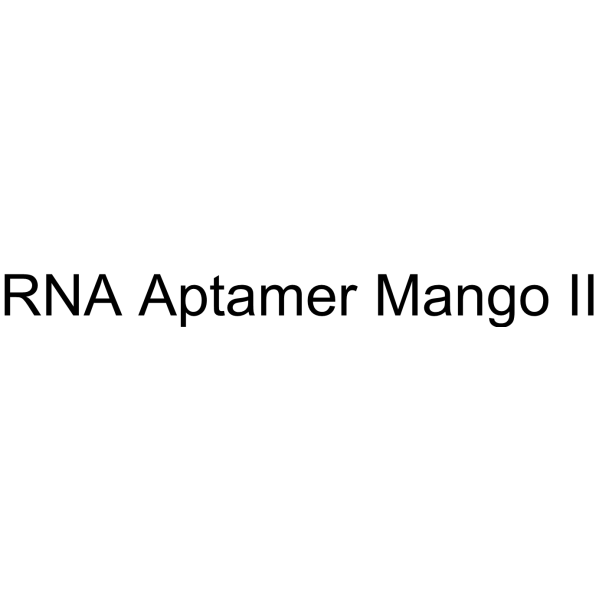
-
- HY-153848
-
|
|
Others
|
Others
|
|
RNA Aptamer Mango Ⅳ (sodium) has an exceptionally high affinity to TO1-biotin (a thiazole orange derivative fluorophore), and can be used to visualize RNA expression or localization in live cells. Compared to the original Mango I aptamer, RNA Aptamer Mango Ⅳ has markedly improved fluorescent properties, binding affinities, and salt dependencies.
|
-
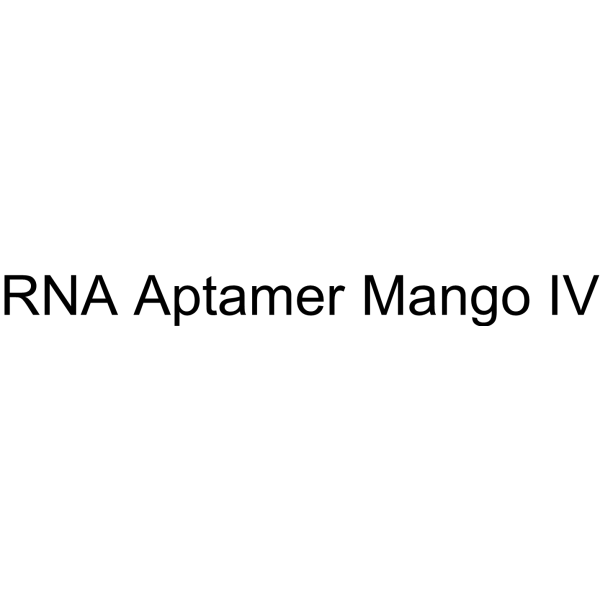
-
- HY-153849
-
|
|
Others
|
Others
|
|
RNA Aptamer Mango Ⅲ (sodium) has an exceptionally high affinity to TO1-biotin (a thiazole orange derivative fluorophore), and can be used to visualize RNA expression or localization in live cells. Compared to the original Mango I aptamer, RNA Aptamer Mango Ⅲ has markedly improved fluorescent properties, binding affinities, and salt dependencies.
|
-
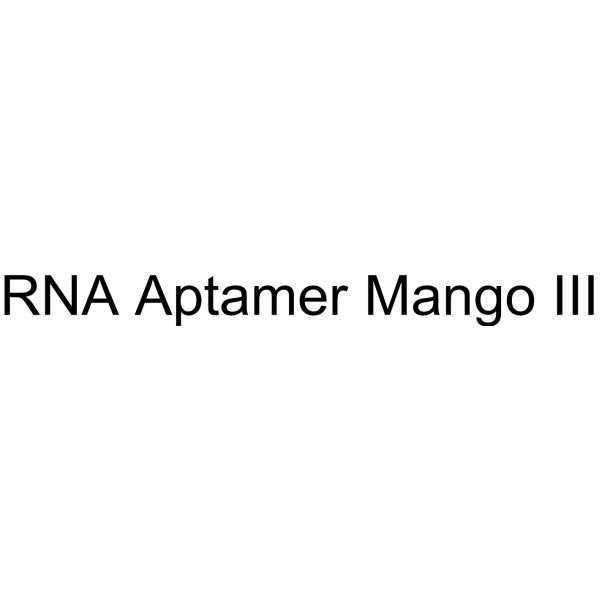
-
- HY-163146
-
|
|
Fluorescent Dye
|
Cancer
|
|
TME-HYM (PH Probe) is a novel fluorescent probe based on acidic tumor microenvironment (TME) activation and organic anion transporting polypeptide (OATPs, overexpressed on cancer cells), and can be selective uptaken. TME-HYM (PH Probe) can selectively lit up cancer cells and tumor tissues, offering dual tumor selectivity for precise visualization of tumor mass .
|
-
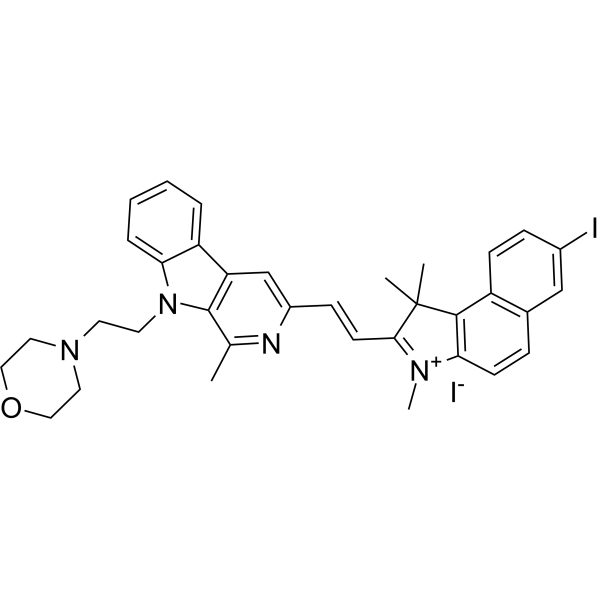
-
- HY-109513
-
|
|
Biochemical Assay Reagents
|
Others
|
|
Ioxilan is a low-osmolar, nonionic and tri-iodinated diagnostic contrast agent. Ioxilan is also an X-ray contrast agent for excretory urography and contrast enhanced computed tomographic (CECT) imaging of the head and body. Intravascular injection results in opacification of vessels in the path of flow of the contrast medium, permitting radiographic visualization of the internal structures of the human body until significant hemodilution occurs .
|
-
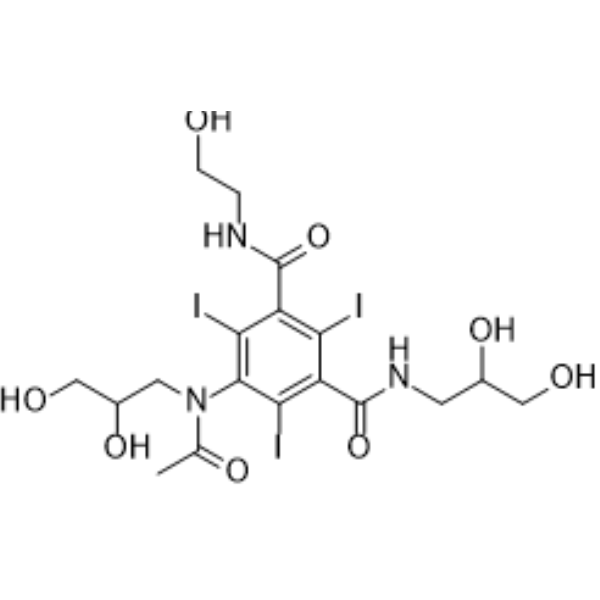
-
- HY-W010042
-
|
L-(-)-Glucose
|
Others
|
Metabolic Disease
Cancer
|
|
L-Glucose (L-(-)-Glucose) is a stereoisomer of D-Glucose (HY-B0389), which does not readily enter the brain. L-Glucose can promote food intake. L-glucose is combined with a fluorescence detector to produce a fluorescent probe that can be used to visualize and characterize cancer cells. L-Glucose also can be used in the research to enhance memory in mice .
|
-
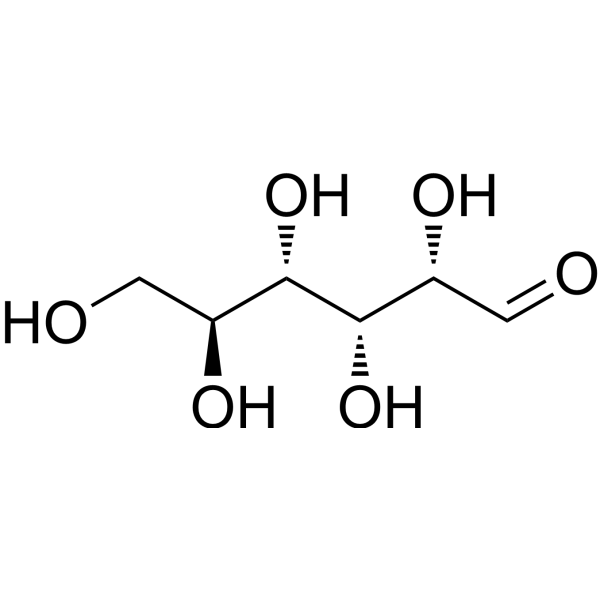
- HY-D1168
-
|
|
Fluorescent Dye
|
Metabolic Disease
|
|
Oil Red O is a fat-soluble diazol dye, with a maximum absorption at 518 nm. Oil Red O stains neutral lipids and cholesteryl esters but not biological membranes. Oil Red O can be used for detecting and quantifying hepatic steatosis in mouse liver biopsies. Oil Red O staining efficiently helps to visualize the radical changes that occur in tissues as metabolic disease occurs and progresses .
|
-
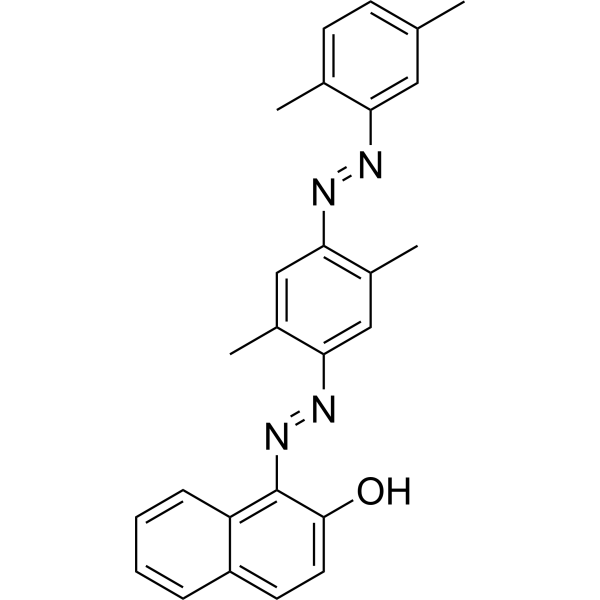
- HY-163281
-
|
|
Fluorescent Dye
|
Cancer
|
|
FSY-OSO2F is used as an amino acid tracer for subsutaneous MCF-7 tumors after labeling with isotope 18F. FSY-OSO2F shows an uptake in MCF-7 cells through the regulation of L-Tyr, ASC, and ASC2 transporters. FSY-OSO2F visualizes the U78MG glioma labeled with 18F .
|
-
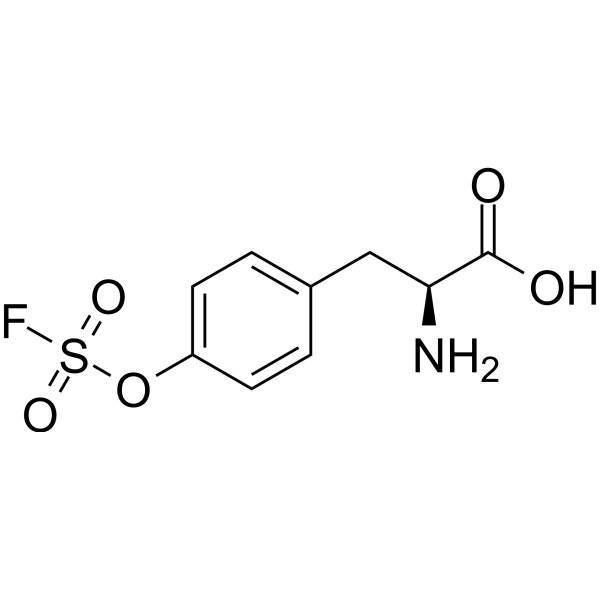
- HY-D2300
-
|
|
Fluorescent Dye
|
Others
|
|
mgc(3Me)FDA is fluorescein diacetate (FDA) modified with a cell-permeable myrGC 3Me motif. mgc(3Me)FDA can enter cells and be converted into fluorescently active mgc(3Me)FL (HY-D2301) within the cells. mgc(3Me)FDA is subcellularly localized in the Golgi apparatus and is a visualized Golgi probe .
|
-
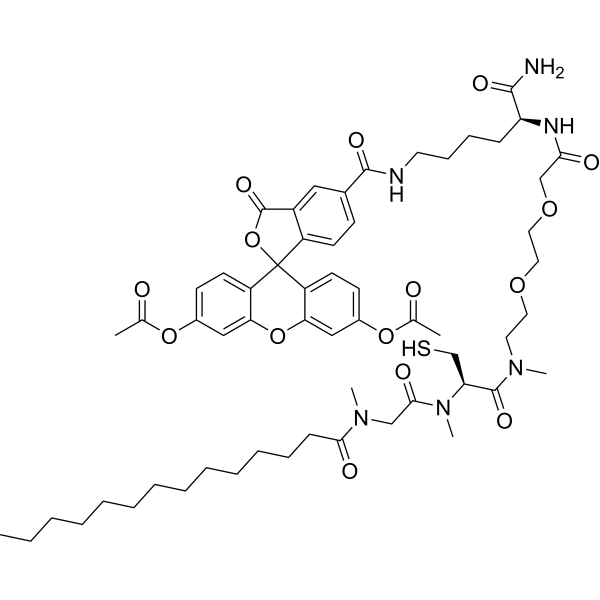
- HY-D2301
-
|
|
Fluorescent Dye
|
Others
|
|
mgc(3Me)FL is the active fluorescent form of mgc(3Me)FDA (HY-D2300) after hydrolysis in cells. mgc(3Me)FL subcellularly localizes to the Golgi apparatus and is a visualized Golgi probe. mgc(3Me)FL also binds to the outer leaflet of the plasma membrane (PM), causing the plasma membrane to fluoresce .
|
-
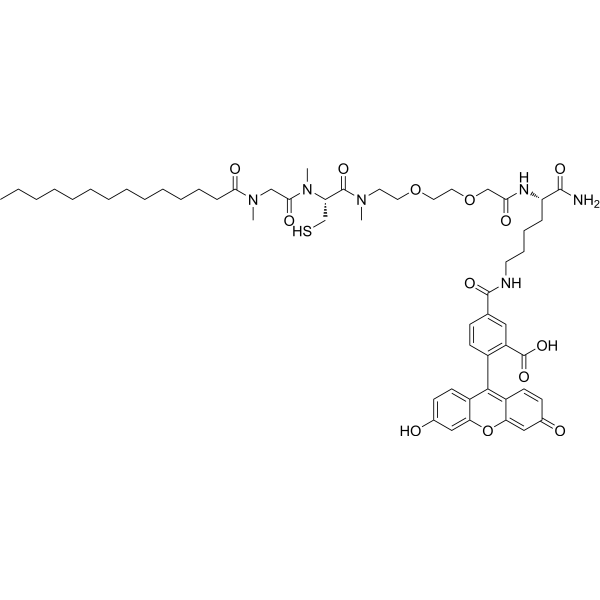
- HY-D0014
-
|
|
Biochemical Assay Reagents
|
Others
|
|
Brilliant Blue G-250 is a dye commonly used for the visualization of proteins separated by SDS-PAGE, offering a simple staining procedure and high quantitation. In the Bradford protein assay, protein concentrations are determined by the absorbance at 595 nm due to the binding of Brilliant Blue G-250 to proteins. Brilliant Blue G-250 is a safe highly selective P2×7R antagonist with promising consequent inactivation of NLRP3 inflammasome .
|
-
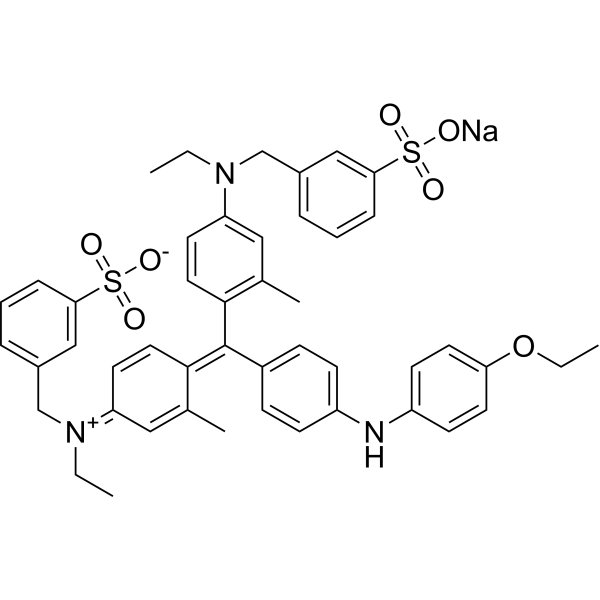
- HY-158082
-
|
Tetramethyl rhodamine isothiocyanate glucan, MW 4000
|
Fluorescent Dye
|
Others
|
|
TRITC-dextran MW 4000 (Tetramethyl rhodamine isothiocyanate glucan, MW 4000) is a fluorescent dye, with the molecular weight of 4 kD. TRITC-dextran MW 4000 exhibits an excitation wavelength of 555 nm. TRITC-dextran MW 4000 is vessel penetrate, which could label blood plasma to visualize the vasculature. TRITC-dextran MW 4000 is utilized in drug delivery for the stability of TRITC over a wide pH range (i.e. pH 2–11) and resistance to photo-bleaching .
|
-
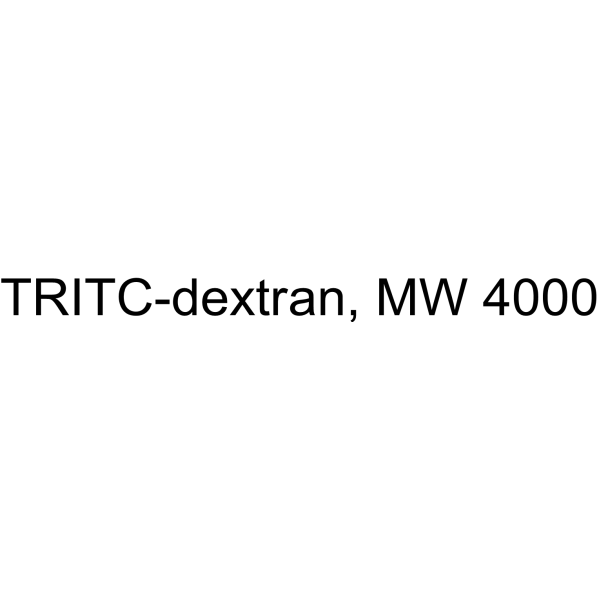
- HY-158082A
-
|
Tetramethyl rhodamine isothiocyanate glucan, MW 20000
|
Fluorescent Dye
|
Others
|
|
TRITC-dextran, MW 20000 (Tetramethyl rhodamine isothiocyanate glucan, MW 20000) is a fluorescent dye, with the molecular weight of 20 kD. TRITC-dextran MW 20000 exhibits an excitation wavelength of 555 nm. TRITC-dextran MW 20000 is vessel penetrate, which could label blood plasma to visualize the vasculature. TRITC-dextran MW 20000 is utilized in drug delivery for the stability of TRITC over a wide pH range (i.e. pH 2–11) and resistance to photo-bleaching .
|
-
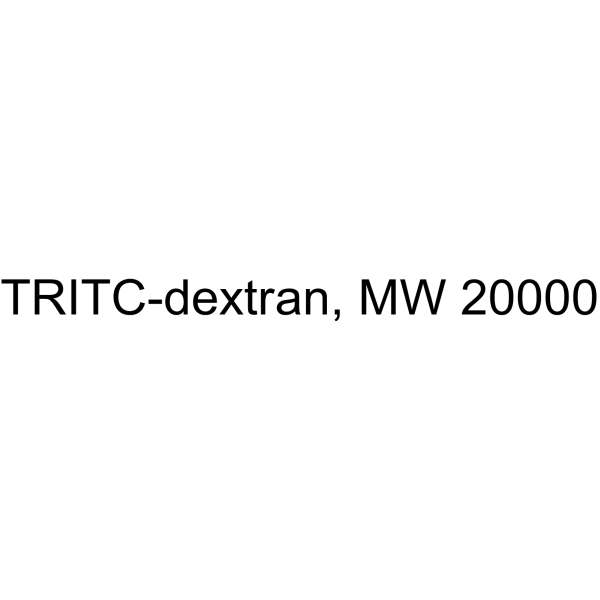
- HY-158082B
-
|
Tetramethyl rhodamine isothiocyanate glucan, MW 40000
|
Fluorescent Dye
|
Others
|
|
TRITC-dextran, MW 40000 (Tetramethyl rhodamine isothiocyanate glucan, MW 40000) is a fluorescent dye, with the molecular weight of 40 kD. TRITC-dextran MW 40000 exhibits an excitation wavelength of 555 nm. TRITC-dextran MW 40000 is vessel penetrate, which could label blood plasma to visualize the vasculature. TRITC-dextran MW 40000 is utilized in drug delivery for the stability of TRITC over a wide pH range (i.e. pH 2–11) and resistance to photo-bleaching .
|
-
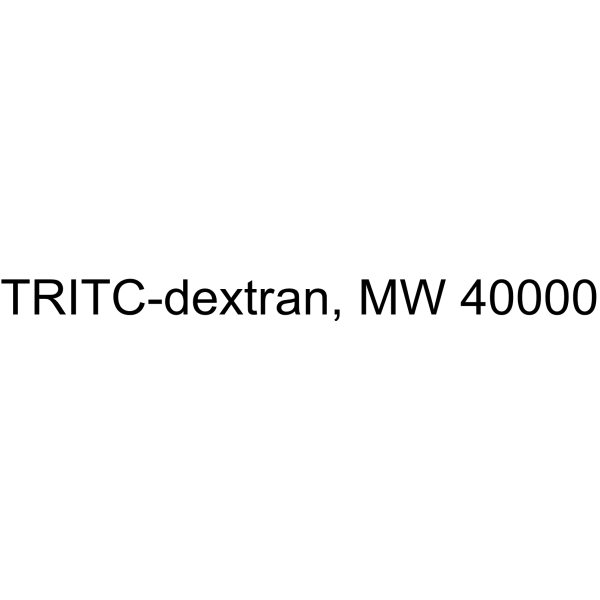
- HY-D2327
-
|
|
Dipeptidyl Peptidase
|
Others
|
|
DPP-8/9 probe-1 (compound 20) is a fluorescent probe targeting Dipeptidyl Peptidase DPP8/9, which can be selectively labeled and visualized in vitro by fluorescence microscopy Active DPP8/9. DPP-8/9 probe-1 contains a nitrobenzoxadiazole (NBD) tag and has high affinity and selectivity for DPP8/9 over related S9 family members (IC50 of 210 nM and 15 nM, respectively). .
|
-
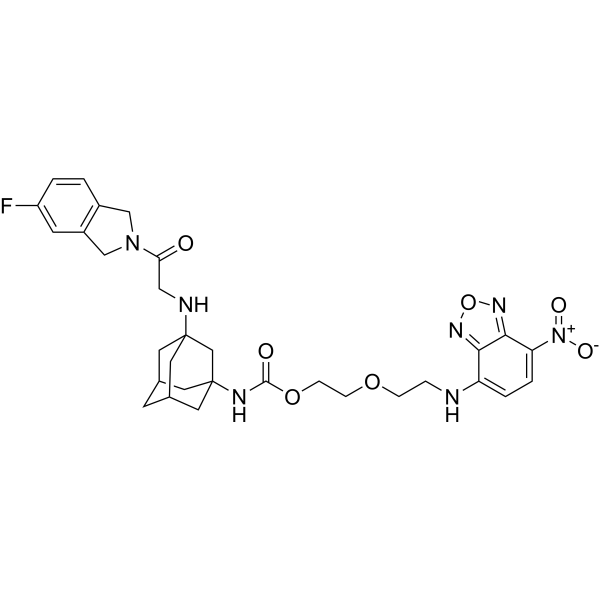
- HY-156124
-
|
|
Sigma Receptor
|
Cancer
|
|
Sigma-2 Radioligand 1 (compound 1) is a Sigma-2 selective ligand. Sigma-2 Radioligand 1 has good biodistribution in mice and good in vivo activity in rats. [18F] Modified Sigma-2 Radioligand 1 for visualization of tumors in micro-PET/CT imaging, exhibiting high tumor uptake and tumor-to-background ratio. Experiments show that Sigma-2 Radioligand 1 binds highly specifically in U87MG glioma xenografts .
|
-
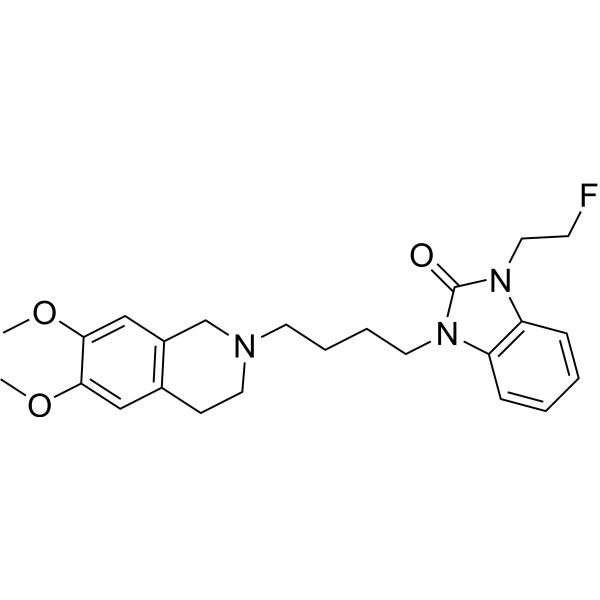
- HY-153845
-
|
|
Others
|
Others
|
|
RNA Aptamer Broccoli (sodium) is a 49-nt-long aptamer that is substantially shorter than Spinach and Spinach2 and exhibits bright green fluorescence upon binding DFHBI or DFHBI-1T (soluble analogs of the fluorophore of green fluorescent protein). RNA Aptamer Broccoli (sodium) can be used to visualize RNA expression or localization in live cells. In vitro Broccoli exhibits a similar high folding efficiency as Spinach2, but exhibits markedly lower dependence on magnesium for folding and increased thermostability. Additionally, unlike Spinach2, Broccoli does not require the use of a tRNA scaffold to promote its folding in vivo.
|
-
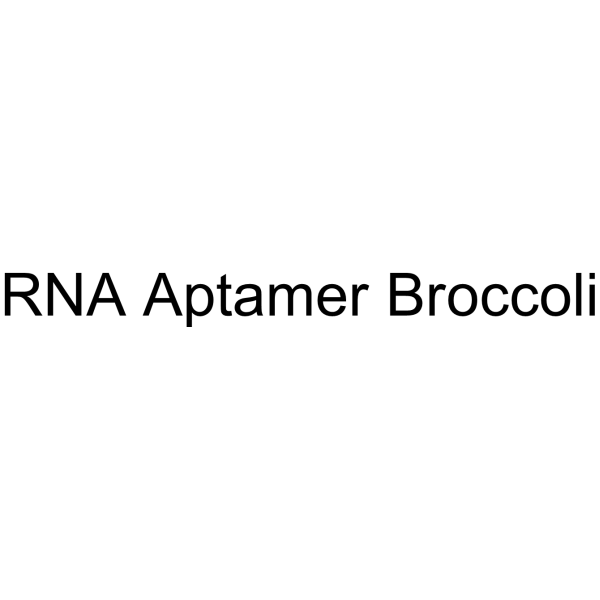
- HY-153843
-
|
|
Others
|
Others
|
|
RNA Aptamer Corn (sodium) is a 28-nt-long aptamer that is substantially shorter than Spinach and Spinach2 and exhibits bright red fluorescence upon binding DFHO (a soluble analog of the intrinsic fluorophore of red fluorescent protein), RNA Aptamer Corn (sodium) can be used to visualize RNA expression or localization in live cells which have been soaked with chromophores. The Corn-DFHO does not become appreciably cytotoxic when illuminated. And most importantly, Corn-DFHO exhibits markedly increased photostability compared to other aptamer-chromophore complexes both in vitro and in vivo. (36 nt Corn construct: 5'-GGCGCGAGGAAGGAGGUCUGAGGAGGUCACUGCGCC-3'; A 36-nt RNA construct, comprised of the 28-nt minimal Corn sequence extended proximally with a 4 base-pair stem.)
|
-
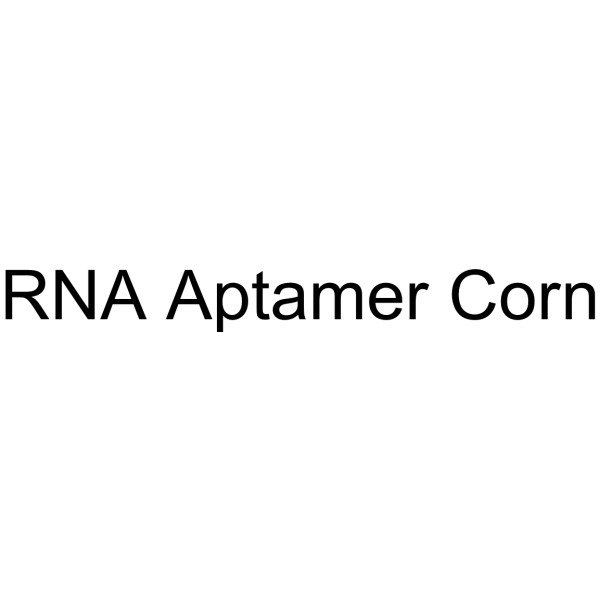
| Cat. No. |
Product Name |
Type |
-
- HY-15930C
-
|
BM blue monosulfate; Sure Blue TMB monosulfate
|
Chromogenic Substrates
|
|
TMB monosulfate is a chromogenic substrate used in staining procedures in immunohistochemistry as well as being a visualizing reagent used in enzyme-linked immunosorbent assays (ELISA).
|
-
- HY-12489A
-
|
Acid Red 112, BS
|
Dyes
|
|
Both Ponceau S and Ponceau BS are synthetic dyes commonly used in biological research. They are commonly used as protein stains to visualize proteins in western blots and other protein detection analyses. Ponceau S is a red dye, while Ponceau BS is a blue shade of the same dye. Both dyes bind to positively charged amino acid residues in proteins for easy visualization. However, Ponceau S is more commonly used due to its higher sensitivity.
|
-
- HY-D1751
-
|
|
Fluorescent Dyes/Probes
|
|
RIM-1 is a fluorescent probe for protein kinase C (PKC) that can be used to visualize the distribution of PKC in cells.
|
-
- HY-D2248
-
|
|
Fluorescent Dyes/Probes
|
|
ICG-TCO is a fluorescent dye coupled by Indocyanine Green (ICG) and TCO. ICG-TCO can be used for detection and visualization of tetrazine-containing molecules.
|
-
- HY-D1350
-
|
|
Fluorescent Dyes/Probes
|
|
5-ROX-alkyne is a rhodamine dye that labels DNA fragments. It enables visualization of the results of capillary electrophoresis genotyping experiments and gel shift experiments.
|
-
- HY-D2302
-
|
|
Fluorescent Dyes/Probes
|
|
mgc(3Me)DEAC (compound mgc3MeDEAC) is a small-molecule fluorescent probe enabling visualization of the Golgi apparatus in living cell .
|
-
- HY-D1535
-
|
|
Fluorescent Dyes/Probes
|
|
IR 813 perchlorate is a near-infrared (NIR) fluorescent dye (Ex=815 nm, Em=840 nm) and can be used for visualizing regional lymph nodes in mice .
|
-
- HY-D1542
-
|
|
Dyes
|
|
Mucicarmine is used in the histological visualization of acid mucopolysaccharides in tissue sections. Mucicarmine can identify mucin (deep rose), which is useful in determining the mucin positive cancer (such as liver carcinoma) .
|
-
- HY-D1311
-
|
|
Dyes
|
|
R110 azide, 6-isomer is an isomer of rhodamine dye with an azide group that labels DNA fragments. It enables visualization of the results of capillary electrophoresis genotyping experiments and gel shift experiments.
|
-
- HY-D1525
-
|
|
Fluorescent Dyes/Probes
|
|
N-(7-Nitrobenzofurazan-4-yl)phallacidin is a fluorochrome. N-(7-Nitrobenzofurazan-4-yl)phallacidin can be used visualizing probe for actin .
|
-
- HY-151890
-
|
|
Fluorescent Dyes/Probes
|
|
NIR-βgal-2 is a β-galactosidase-activated near-infrared fluorescent probe with superior sensitivity. NIR-βgal-2 can be used for visualizing β-galactosidase in breast cancer .
|
-
- HY-133520
-
|
|
Fluorescent Dyes/Probes
|
|
HBC620 is a HBC analog. HBC is nonfluorescent in solution, but emits strong fluorescence upon forming tight complex with Pepper RNA aptamer. HBC-Pepper complex can be used to visualize RNA dynamics in live cells .
|
-
- HY-133521
-
|
|
Dyes
|
|
HBC599 is a HBC analog. HBC is nonfluorescent in solution, but emits strong fluorescence upon forming tight complex with Pepper RNA aptamer. HBC-Pepper complex can be used to visualize RNA dynamics in live cells .
|
-
- HY-D2119
-
|
|
Fluorescent Dyes/Probes
|
|
CQ-Lyso is a lysosome-targeting chromenoquinoline. CQ-Lyso is a fluorescent probe for measuring the pH of lysosomes in living cells using only single wavelength excitation. CQ-Lyso can visualize the dynamic pH changes in lysosomes .
|
-
- HY-D2263
-
|
|
Dyes
|
|
BODIPY-cholesterol conjugate-3 (compound 7) is a cholesterol analogue with a fluorescent BODIPY group. BODIPY-cholesterol conjugate-3 can be used to simultaneously visualize multiple cholesterol pools in cells, as it is primarily localized to the plasma membrane .
|
-
- HY-D2255
-
|
|
Fluorescent Dyes/Probes
|
|
BDP FL ceramide, a highly fluorescent lipid, is a conjugate of green-emitting BDP FL fluorophore with sphingosine. BDP FL ceramide can be used for the visualization of the Golgi apparatus via fluorescence microscopy.The excitation wavelength is 503 nm and the emission wavelength is 509 nm .
|
-
- HY-W133919
-
|
|
Dyes
|
|
Aniline Blue sodium is a water-soluble dye commonly used as a biological stain for the detection of nucleic acids and proteins in various laboratory procedures such as electrophoresis and microscopy. Aniline Blue sodium has unique chemical properties that allow it to bind to specific cellular components, producing a color change that facilitates their visualization and analysis.
|
-
- HY-D2262
-
|
|
Dyes
|
|
BODIPY-cholesterol conjugate-2 (compound 6) is a BODIPY-cholesterol conjugate. BODIPY-cholesterol conjugate-2 is a useful probe for simultaneous visualization of intracellular cholesterol pools and for monitoring cholesterol efflux from cells to extracellular acceptors. (λex=589 nm, λem=638 nm) .
|
-
- HY-133523
-
|
|
DNA Stain
|
|
HBC514 is a nonfluorescent HBC-analog but emits strong green fluorescence upon forming a tight complex with Pepper RNA aptamer. HBC514-Pepper complex enables visualization of RNAs and the fluorescences can be altered flexibly by simple washing and staining in living Pepper-tagged cells[1].
|
-
- HY-151544
-
|
|
Fluorescent Dyes/Probes
|
|
PNE-Lyso is a activatable fluorescent probe. PNE-Lyso can be used to detect intracellular pH and hexosaminidases with two kinds of fluorescence signals. PNE-Lyso can be used to distinguish apoptosis from necrosis through visualizing lysosome morphology. PNE-Lyso is capable of investigating the agent-induced cell death process .
|
-
- HY-151537
-
|
|
Fluorescent Dyes/Probes
|
|
Gol-NTR is a Golgi-targetable probe with high selectivity and sensitivity. Gol-NTR is Nitroreductase (NTR)-activated and has visualization acute lung injury (ALI) and repair function. Gol-NTR has a low detection limit of 54.8 ng/mL. Gol-NTR can be used for the research for monitoring and assessing research response of sepsis-induced ALI .
|
-
- HY-D1168
-
|
|
Fluorescent Dyes/Probes
|
|
Oil Red O is a fat-soluble diazol dye, with a maximum absorption at 518 nm. Oil Red O stains neutral lipids and cholesteryl esters but not biological membranes. Oil Red O can be used for detecting and quantifying hepatic steatosis in mouse liver biopsies. Oil Red O staining efficiently helps to visualize the radical changes that occur in tissues as metabolic disease occurs and progresses .
|
-
- HY-D2300
-
|
|
Fluorescent Dyes/Probes
|
|
mgc(3Me)FDA is fluorescein diacetate (FDA) modified with a cell-permeable myrGC 3Me motif. mgc(3Me)FDA can enter cells and be converted into fluorescently active mgc(3Me)FL (HY-D2301) within the cells. mgc(3Me)FDA is subcellularly localized in the Golgi apparatus and is a visualized Golgi probe .
|
-
- HY-D2301
-
|
|
Fluorescent Dyes/Probes
|
|
mgc(3Me)FL is the active fluorescent form of mgc(3Me)FDA (HY-D2300) after hydrolysis in cells. mgc(3Me)FL subcellularly localizes to the Golgi apparatus and is a visualized Golgi probe. mgc(3Me)FL also binds to the outer leaflet of the plasma membrane (PM), causing the plasma membrane to fluoresce .
|
-
- HY-D2327
-
|
|
Fluorescent Dyes/Probes
|
|
DPP-8/9 probe-1 (compound 20) is a fluorescent probe targeting Dipeptidyl Peptidase DPP8/9, which can be selectively labeled and visualized in vitro by fluorescence microscopy Active DPP8/9. DPP-8/9 probe-1 contains a nitrobenzoxadiazole (NBD) tag and has high affinity and selectivity for DPP8/9 over related S9 family members (IC50 of 210 nM and 15 nM, respectively). .
|
| Cat. No. |
Product Name |
Type |
-
- HY-P3152
-
|
|
Native Proteins
|
|
Streptavidin is a ∼60 kDa homotetramer. Streptavidin binds four molecules of biotin with the highest affinity. The binding affinity of biotin to streptavidin is one of the highest reported for a non-covalent interaction to date, with a KD ∼ 0.01 pM . Streptavidin has an immunosuppressive role .
|
-
- HY-D0014
-
|
|
Biochemical Assay Reagents
|
|
Brilliant Blue G-250 is a dye commonly used for the visualization of proteins separated by SDS-PAGE, offering a simple staining procedure and high quantitation. In the Bradford protein assay, protein concentrations are determined by the absorbance at 595 nm due to the binding of Brilliant Blue G-250 to proteins. Brilliant Blue G-250 is a safe highly selective P2×7R antagonist with promising consequent inactivation of NLRP3 inflammasome .
|
-
- HY-158082
-
|
Tetramethyl rhodamine isothiocyanate glucan, MW 4000
|
Cell Assay Reagents
|
|
TRITC-dextran MW 4000 (Tetramethyl rhodamine isothiocyanate glucan, MW 4000) is a fluorescent dye, with the molecular weight of 4 kD. TRITC-dextran MW 4000 exhibits an excitation wavelength of 555 nm. TRITC-dextran MW 4000 is vessel penetrate, which could label blood plasma to visualize the vasculature. TRITC-dextran MW 4000 is utilized in drug delivery for the stability of TRITC over a wide pH range (i.e. pH 2–11) and resistance to photo-bleaching .
|
-
- HY-158082A
-
|
Tetramethyl rhodamine isothiocyanate glucan, MW 20000
|
Cell Assay Reagents
|
|
TRITC-dextran, MW 20000 (Tetramethyl rhodamine isothiocyanate glucan, MW 20000) is a fluorescent dye, with the molecular weight of 20 kD. TRITC-dextran MW 20000 exhibits an excitation wavelength of 555 nm. TRITC-dextran MW 20000 is vessel penetrate, which could label blood plasma to visualize the vasculature. TRITC-dextran MW 20000 is utilized in drug delivery for the stability of TRITC over a wide pH range (i.e. pH 2–11) and resistance to photo-bleaching .
|
-
- HY-158082B
-
|
Tetramethyl rhodamine isothiocyanate glucan, MW 40000
|
Cell Assay Reagents
|
|
TRITC-dextran, MW 40000 (Tetramethyl rhodamine isothiocyanate glucan, MW 40000) is a fluorescent dye, with the molecular weight of 40 kD. TRITC-dextran MW 40000 exhibits an excitation wavelength of 555 nm. TRITC-dextran MW 40000 is vessel penetrate, which could label blood plasma to visualize the vasculature. TRITC-dextran MW 40000 is utilized in drug delivery for the stability of TRITC over a wide pH range (i.e. pH 2–11) and resistance to photo-bleaching .
|
-
- HY-K2006
-
1 Publications Verification
|
|
Sensitive ECL Kit enables low picogram detection of antigen by oxidizing luminol in the presence of HRP and peroxide. This reaction produces a prolonged chemiluminescence which can be visualized on X-ray film or digital imaging systems.
|
-
- HY-K2005
-
1 Publications Verification
|
|
High Sensitivity ECL Kit enables low picogram detection of antigen by oxidizing luminol in the presence of HRP and peroxide. This reaction produces a prolonged chemiluminescence which can be visualized on X-ray film or digital imaging systems.
|
| Cat. No. |
Product Name |
|
Classification |
-
- HY-129084
-
|
|
|
Alkynes
|
|
Propargylcholine bromide is a choline analogue containing terminal propargyl that can be incorporated into all classes of Choline-containing phospholipids such as phosphatidylcholine and sphingomyelin, labeling Choline-containing phospholipids. Propargylcholine bromide-labeled phospholipid molecules can be visualized in cells with high sensitivity and spatial resolution. Propargylcholine bromide can be used as a molecular tool to study the biochemical and metabolic processes of Choline-containing phospholipids in cells . Propargylcholine (bromide) is a click chemistry reagent, it contains an Alkyne group and can undergo copper-catalyzed azide-alkyne cycloaddition (CuAAc) with molecules containing Azide groups.
|
-
- HY-152901
-
|
|
|
Azide
|
|
Chol-N3 is a bioorthogonal-based chol probe. Chol-N3 can combine with super-resolution fluorescence microscopy (SRM), providing direct visualization of nanoscale lipid heterogeneity in the cell surface of resting living cells . Chol-N3 is a click chemistry reagent, it contains an Azide group and can undergo copper-catalyzed azide-alkyne cycloaddition reaction (CuAAc) with molecules containing Alkyne groups. Strain-promoted alkyne-azide cycloaddition (SPAAC) can also occur with molecules containing DBCO or BCN groups.
|
-
- HY-D2248
-
|
|
|
TCO
|
|
ICG-TCO is a fluorescent dye coupled by Indocyanine Green (ICG) and TCO. ICG-TCO can be used for detection and visualization of tetrazine-containing molecules.
|
-
- HY-D1350
-
|
|
|
Alkynes
|
|
5-ROX-alkyne is a rhodamine dye that labels DNA fragments. It enables visualization of the results of capillary electrophoresis genotyping experiments and gel shift experiments.
|
-
- HY-D1311
-
|
|
|
Azide
|
|
R110 azide, 6-isomer is an isomer of rhodamine dye with an azide group that labels DNA fragments. It enables visualization of the results of capillary electrophoresis genotyping experiments and gel shift experiments.
|
Your information is safe with us. * Required Fields.
Inquiry Information
- Product Name:
- Cat. No.:
- Quantity:
- MCE Japan Authorized Agent:






































































